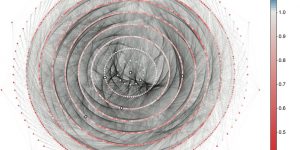Our goal is to understand and to be able to predict phenotypic variation amongst individuals. Our work is currently focused in three areas: (1) how mutations combine within and between genes to alter phenotypes; (2) mutation processes and selection in cancer genomes; (3) the impact of noise and inter-generational epigenetics on mutation outcomes and inter-individual variation.
1. Genetic prediction, genetic interactions, genotype-phenotype maps: We have been using deep mutagenesis to better understand how mutations interact within and between genes to affect a range of molecular functions and phenotypes. These include the activity of individual proteins and RNAs, protein interactions, splicing, and regulatory networks. We have found that both pairwise and higher-order interactions between mutations are quite common, with mutations switching from positive to negative effects, even in closely related genotypes. These genetic (epistatic) interactions are of two classes: non-specific (global) interactions resulting from non-linearities in genotype-phenotype maps and specific interactions related to structure. Indeed, we have found that quantifying how mutations interact within and between proteins can provide sufficient restraints to predict the contact maps and three-dimensional structures or protein domains. The structure of a biological macromolecule can therefore be determined simply by measuring the activity of mutant variants of that molecule in a selection experiment. This opens up exciting possibilities for ‘in vivo’ structural biology.
2. Mutation and selection in cancer: As part of our interest in stochastic processes, we have been using data from cancer genome sequencing projects to better understand the distribution and spectra of somatic mutations in human cells and how these interact with each other and with inherited germline variants to cause cancer. Large-scale tumour sequencing has revolutionized the identification of somatic driver alterations but has had limited impact on the identification of cancer predisposition genes. We developed a statistical method, ALFRED, that tests Knudson’s two-hit hypothesis to systematically identify cancer predisposition genes from cancer genome data. Applied to ~10,000 tumour exomes the approach identifies known and putative cancer predisposition genes – including the chromatin modifier NSD1 – that contribute to cancer through a combination of rare germline variants and somatic loss-of-heterozygosity (LOH). We estimate that rare germline variants in these genes contribute to a median of 2% of tumours across 17 cancer types.
3. Noise and inter-generational epigenetics: We are using C. elegans and yeast as model systems to understand how epigenetic inheritance and noise can impact physiology and mutation outcomes in isogenic individuals.
Domingo J, Diss G, Lehner B.
“Pairwise and higher-order genetic interactions during the evolution of a tRNA.”
Nature, 558(7708):117-121, 2018.
Diss G, Lehner B.
“The genetic landscape of a physical interaction.”
Elife, 7. pii: e32472, 2018.
Park S, Supek F, Lehner B.
“Systematic discovery of germline cancer predisposition genes through the identification of somatic second hits.”
Nature Communications, 9(1):2601, 2018.
Avgustinova A, Symeonidi A, Castellanos A, Urdiroz-Urricelqui U, Solé-Boldo L, Martín M, Pérez-Rodríguez I, Prats N, Lehner B, Supek F, Benitah SA.
“Loss of G9a preserves mutation patterns but increases chromatin accessibility, genomic instability and aggressiveness in skin tumours.”
Nat Cell Biol, 2018 Nov 19.

